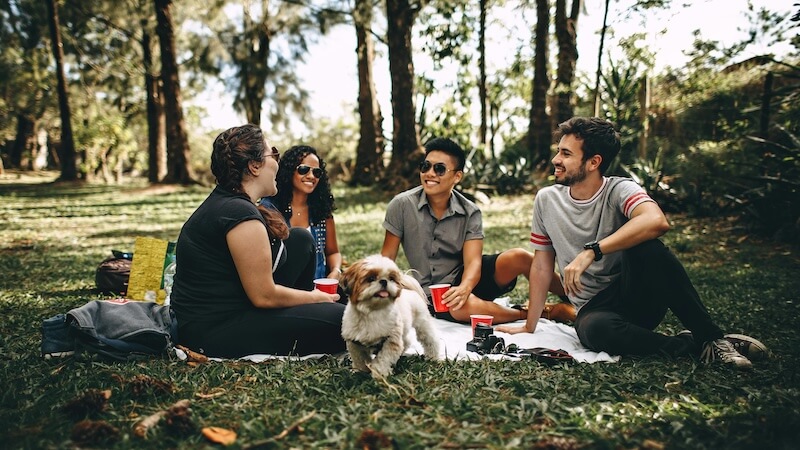Mastering Lots of Friendships
Episode #5 of the course Mastering your relationships by John Robin
Welcome back to the course!
Yesterday we talked about using the “new mapping” technique to get more out of close friendships. We also saw how to bring more spontaneity into this approach by adopting the “whatever arises” orientation.
Now, we will return to the topic of how to manage many friendships without losing your mind!
Balancing Friendships: The Art of Proportioning Your Year
How many friends do you have?
If you just counted close friends, you might just have a few. But if you tried to think of everyone you spend time with at least once a year, you might list ten or twenty. If you think of everyone you spent time with in the last three years, you might make that list even larger.
If you took it one step further and tried to write down all the people you haven’t seen, but you feel you have fallen out of touch with because you’ve both gotten too busy, well, you might have easily thirty people.
This is a lot of people to try and spend time with. How do you manage it all?
The art of mastering lots of friendships comes down to proportioning your year.
We tend to live in a small bubble of time. We wake up and it’s “today.” You might have some ideas of what’s ahead tomorrow, or later in the week. If there’s a special event coming up, you might have some idea what you’ll be up to later in the month, or two to three months ahead, but usually that’s it.
The art of proportioning your year involves expanding this bubble to cover a whole year. Once you get the hang of it, you will feel much more empowered in how you can spend time with those you value in your life without becoming overwhelmed.
The idea is to determine how you want to divide the time you spend with people over the span of a whole year. To do this, we will use a year-at-a-glance calendar.
This exercise works well if you use different color pens for different groups. First, in one color, fit in all family commitments you have established from lesson 3. Then, in a separate color, for each close friend, mark somewhere on the calendar when you’d like to see them. Now, with a new color, think of a few other friends you don’t see as much but who think you’d like to see at least once a year.
Your goal is to schedule all your friendships along with your family time over the span of a year, so you can see just how busy you will be if you try to keep everything up.
After the first go-around, you may find the calendar looks overwhelming. It may be helpful to do it a second time with a new calendar, using your first as a reference. In the first round, your goal was to get everything in place. Now that you can see it, in the second round, try to balance it out.
Be objective when doing this. Who do you like to see the most and have you scheduled the right amount of time with them? Who are you seeing more frequently than you want and need to see less?
As you’re doing this exercise, you will be evaluating how much time you have for others and if you are perhaps over-committed within some relationships. As you look at each relationship, really consider how often you’d like to see that person. Ask yourself if it’s too much, or too little.
For example, do you have a friend you presently see once a week? Is that the right frequency? If you’re feeling your weeks are too full, what if you only saw that friend every 2nd week?
What you will have once you do this exercise, is a game plan for when, throughout the year, you can try to see your friends. You also will have a handy guide to where you need to set some boundaries.
When I first did this exercise, I found it helped me become more proactive in reaching out to people I’d fallen out of touch with, making plans to get together for coffee, or a dinner, or a walk to catch up. It also helped me maintain those friendships. Instead of, “we should do this again!” turning into years of falling out of touch, it became a prompt to master my friendships by scheduling them on my calendar for when I want to reach out to them next, rather than just leaving things up in the air.
Tip of the Day: Remember, the Calendar Is a Living Document
Once you see how big a year is, and how many opportunities there are for you to make plans, it changes your sense of how, over the course of the coming weeks, you can juggle your social plans.
The tradeoff, though, is if you get too fixated on this calendar, you might become too rigid in your planning.
For example, I found the calendar useful during the first two years of doing this, but after the third year, I was much more spontaneous. Those first two years were spent breaking the ice of lots of relationships that had stagnated, but then through this process I discovered who I enjoyed spending more time with, and who I was content to connect with annually, or perhaps every two years. That gave me a flow to my relationships, and now, several years later, I’m still in regular contact with everyone of importance to me.
Stay tuned for our next lesson, where we’ll be moving on to discuss mastering our acquaintances!
Recommended book
Set Boundaries, Find Peace: A Guide to Reclaiming Yourself by Nedra Glover Tawwab
Share with friends

